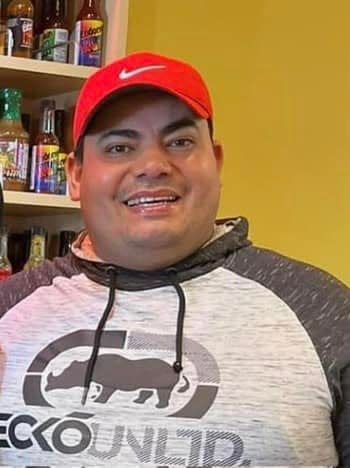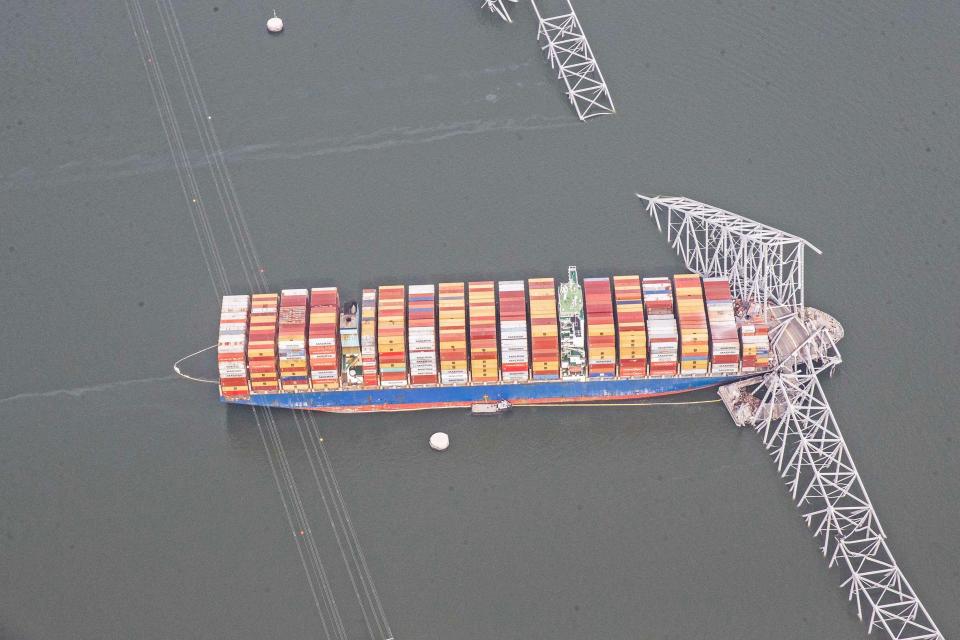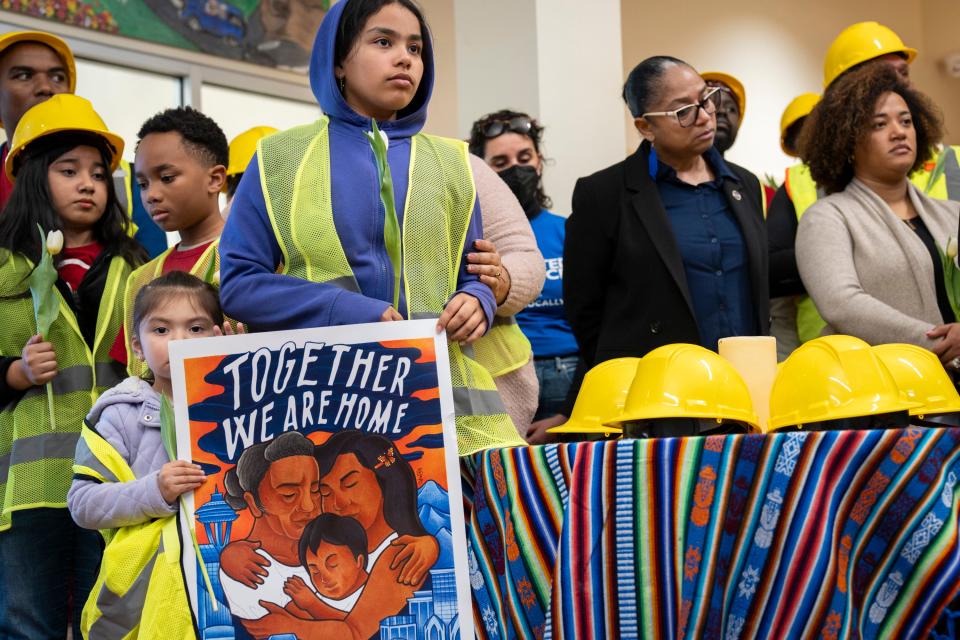Latino communities 'rebuilt' Baltimore. Now they're grieving bridge collapse victims
BALTIMORE – Janet Arce spent Good Friday the same way she’d spent the last several days: driving around Baltimore, clad in a bright pink sweatshirt, picking up Mexican pan dulce, tacos, Salvadoran pupusas and arroz con pollo and delivering the treats to first responders and those cleaning up the Baltimore bridge collapse.
The last stop of the day for the 51-year-old Puerto Rico native who has lived in the city for nearly three decades was the Maryland Transportation Authority. She’s become a familiar face, greeted with smiles and waves from the officials working at the scene not far from the wreckage.
Arce said that like the victims, many of those who responded to the tragedy are Latinos, which they say has made the work even more challenging because they share many of the same life experiences. The impact has been huge and the recovery process will be long, she said, “because all these people come here for a dream, and you find that, then you lose your life.”
Bridge updates: Biden says he will travel to Baltimore next week following bridge collapse
She got emotional Friday as she scrolled through pictures and videos of some of the victims and their families. Saturday, she said she’ll be up early yet again to deliver Easter baskets to the children of the grieving families.
“I don't even know none of them,” she said, wiping away tears. “It's just, you know, you feel the pain.”
Many Latino communities are mourning after the collapse of the Francis Scott Key Bridge, which claimed the lives of six workers from Honduras, El Salvador, Guatemala, and Mexico. The bridge served as an entryway for many in finding work to improve the lives of their families in the U.S. and in their home countries. Now, these residents and their advocates say they hope the tragedy will bring people together and, hopefully, lead to better protections for the many Latinos working dangerous jobs.

Growing community
The population of Baltimore County that identifies as Hispanic or Latino has grown from just 1.8% in 2000 to 7% in 2020, according to the latest census. Census data shows about 12% of Baltimore County residents are foreign born.
Much of the city’s Latino residents are first- or second-generation immigrants who live in the east Baltimore area of Highlandtown, but others have moved farther out in the county into the Dundalk and Essex area, according to Angelo Solera, founder and executive director of Nuestras Raices Inc., a Latino nonprofit cultural organization. But he said the community is largely underserved.
“Baltimore city is primarily a Black and white city, even though we are here in Baltimore city and many of us have been here for generations,” he said. “The biggest problem that we have in Baltimore city is the lack of representation.”
Solera said many Latino immigrants have found work in construction, landscaping, restaurants or the hospitality industry. Around 37% of immigrant construction workers in the Washington and Baltimore area come from El Salvador, 12% come from Guatemala, and 11% come from both Honduras and Mexico, according to nonprofit CASA.
“Our Latino community has rebuilt Baltimore city,” he said. “If you go to any construction site, any house that has been repaired or reconstructed, Latinos are doing that.”

Solera, who immigrated to Baltimore from Spain about 40 years ago, said the bridge collapse has sent shockwaves through the city’s Hispanic immigrant community. Solera said the community will feel the impact of the loss of the bridge on their daily lives like all other residents, but unlike most Americans, many also know exactly what it’s like to work in such dangerous conditions.
“The fact that the six workers that died in the bridge are Latinos, that is a huge shock for our community,” he said. “I mean, you have people who come to this country in search of the American dream, and they lose their lives trying to get that dream. So for us as immigrants and Latinos, we are very impacted by what happened to these individuals.”
Solera said he, too, worked many hours on the Key Bridge in the 1980s to support his wife and child. At the time, he was undocumented and spoke little English.
“I've put on hundreds of gallons of paint on that bridge under dangerous conditions,” he said. “But at the time, I really didn't have any choice.”
Lives lost: How many people died in Baltimore bridge collapse? What we know about 6 missing workers
He said it’s not clear yet exactly how the tragedy could have been prevented, but he hopes more safeguards for immigrant workers will be put into place in response.
Journalist Pedro Palomino echoed that sentiment, saying he hopes the tragedy wakes immigrant Latino workers up about labor rights, regardless of immigration status, whether it be with an accident at the workplace or wage theft. This isn’t exclusive to Maryland, he said, as many Latino immigrant workers may be afraid to exercise their rights because of their immigration status.
“You’re not reclaiming anything special,” he said in Spanish. “You’re only reclaiming what the law gives you.”
Local and state governments have recognized the community’s growth, said Palomino, director of the news outlets Somos Baltimore Latino and Baltimore Latino Newspaper, which covers topics like immigration reform and community organizations serving Baltimore. He pointed to the city Office of Immigrant Affairs, established a decade ago, which directly serves the community with immigration issues.
And he thinks the bridge collapse has put the Latino community on the map politically, at a time when politicians, particularly Republicans, have used immigration as a talking point.
“Those that lost their lives, all of them are Latino workers,” he said. “This tragedy has put us Latinos in the eyes of politicians that don’t want us.”

‘Stronger united’
The bridge collapse during Holy Week, the most sacred week in Christianity, takes on new meaning in Latino communities that look to churches in the aftermath.
The Rev. Cassandra Nu?ez, the lead pastor of Salem United Methodist Church in Highlandtown said it’s important to follow Christian teachings to focus on the community that remains and sustain it to draw strength. This is particularly true for communities far from their homelands.
“Baltimore and its diverse communities have shown that we’re stronger united,” she wrote in a text message, “and as long as we stay together this, too, shall pass.”
Friday, several workers, donning construction helmets and orange and highlighter-yellow safety vests, gathered inside CASA’s day worker center in Baltimore. They spoke, through translators, of dangers in construction jobs that have resulted in broken bones and spinal fractures. They also spoke of undercut wages, and of the need for immigration reform.

'I'm still crying in the morning'
Alfredo Santiago, a clinical social worker with a focus on grief therapy who lives in Dundalk, said many of his regular clients have mentioned the bridge collapse. Santiago said the loss of the iconic bridge in the city skyline has been jarring for many who are used to driving over it and watching ships move through the port.
“When you go, people are standing at this viewpoint and you can just see the shock,” Santiago said.
Santiago said he’s been trying to practice self care by attending community vigils and limiting his consumption of news. But for some community members, he said addressing the impact of trauma on mental health can be a challenge because of a lack of insurance, financial resources and Spanish-speaking therapists.
Investigations: Baltimore's Key Bridge, opened in 1977, had few ship defenses. Are modern bridges better?
“For some people, priority is not self care, for some people the priority is ‘I have to pay my rent, pay for food on the table,” he said. “I mean, that's their priority, not their mental health, unfortunately.”
To help address this need, Santiago said he volunteers with Pro Bono Counseling, which has interpretation services. He said Centro SOL, an organization connected to Johns Hopkins University that promotes equity in health and opportunities for Latinos, also has Spanish-speaking behavioral health therapists. He recommended waiting a few months to start grief therapy.
“Right now people just need to allow themselves space to feel their emotions, to do whatever rituals they do when they have funerals, whatever the family traditions, country traditions are when it comes to grieving a lost one,” he said.

Highlandtown resident Xochitl Lopez, a 52-year-old from Monterrey, Mexico, has also helped with organizing free support groups with Centro SOL for people to grieve, regardless of immigration status. As an advocate with Comité Latino de Baltimore, she and others have also worked to raise funds for the families.
Saturday morning, she’ll have a meeting to get bilingual mental health services to parents and children in Baltimore’s Brooklyn neighborhood, another fledgling Latino area. After that, she’ll return to work.
Everyone in her community is affected, she said, because everyone can relate to the missing workers. Her husband works in construction, she’s a waitress, and they both have family in Mexico.
“Nobody knows them,” she said in Spanish during a brief phone call. “But everyone says, ‘I’m still crying in the morning.'”
This article originally appeared on USA TODAY: After Baltimore bridge collapse, Latinos grieve, hope for change
